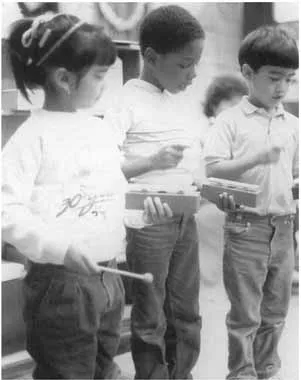![]()
Section II
Model Experiences for Teaching Music
Teaching music to children requires careful planning. This section provides 43 model experiences to serve as samples of what kinds of music learning can actively engage students in kindergarten through grade 5. Because it is important to understand the scope and sequence of which music concepts are appropriate at the different levels and the developmental characteristics of elementary school students, descriptive charts precede the actual model experiences. The model experiences are organized by three levels (K-1, 2-3, and 4-5) with a review and an opportunity to create your own model experience at the end of each level. Monthly planners for use in coordinating the model experiences and music in the text to coincide with various celebrations, seasons, and other special events conclude this section.
- 8 INTRODUCTION TO MODEL EXPERIENCES FOR TEACHING MUSIC
- 9 LEVEL I: KINDERGARTEN AND FIRST GRADE
- 10 LEVEL II: SECOND AND THIRD GRADES
- 11 LEVEL III: FOURTH AND FIFTH GRADES
![]()
8
Introduction to Model Experiences for Teaching Music
- ∎ Scope and Sequence Chart of Music Concepts in Model Experiences, Levels I-III
- ∎ Developmental Characteristics of Kindergarten-5th-Grade Students
- ∎ The Model Experience Format
- ∎ Suggestions for Model Experience Presentations
- ∎ Teaching Tips
Taking turns with the resonator bars Source: Photo by P. Hackett
Introduction to Model Experiences for Teaching Music
Classroom teachers are faced with a myriad of subjects to teach—everything from math to music. State and district standards specifying what students need to know and be able to do are in place for each subject. The challenge for teachers is in putting the planning puzzle together—to ensure that students develop the needed skills and understanding—and in assessing how well they have met those standards. Students seem to learn best when connections are made between subjects. This means that teachers are challenged to plan instruction that will integrate the different subject areas and, as a result, bring about more meaningful student learning. It's a big job to organize all of this instruction sequentially! Teachers have to carefully plan all the various steps needed to maximize student learning in each and every subject.
To meet all of these challenges, teachers must be expert planners. Putting together the puzzle of what needs to happen in the classroom on a daily, weekly, monthly, and yearly basis is an enormous challenge. And, as the pieces are being put in place, special consideration has to be given to how to reach and teach all students. Students come to the classroom with a variety of abilities and disabilities and it is a teacher's responsibility to reach each and every learner.
Most school districts require teachers to have daily, weekly, and monthly plans. These written plans come in various designs, but there are components common to all. Weekly plans reflect the short-range goals, objectives, and standards for each subject; activities/procedures to reach those objectives; materials needed to deliver these activities; and ways to assess student learning. Modifications are made for individual students as needed and as recommended by the student profiles and individualized education programs (IEPs).
To help teachers with planning and teaching the curricular area of music, 43 model experiences follow. Each model specifies what music standards will be met in the learning experience and provides ways to assess music learning. Connections are made to other subject areas to aid in integration of learning. Adaptations and extensions for reaching all learners are offered. Worksheets, picture maps, charts, recordings of all the music (see icons
), and other teaching tools are included to maximize the learning experience and peak student interest.
These individual model experiences can be shared with students in one session (approximately 15-30 minutes depending on the level) and reflect a daily lesson plan design. However, teachers can extend most models using suggested follow-ups and different music selections so the model could be shared several times. These music learning strategies are appropriate for Kindergarten-grade 1 (Level I), grades 2 and 3 (Level II), and grades 4-5 (Level III).
It is possible that by sequencing and extending these models (an abundance of supplementary music from Section III is referenced in the lessons), teachers can organize music instruction on a weekly, monthly, and even yearly basis. Monthly planners ...


